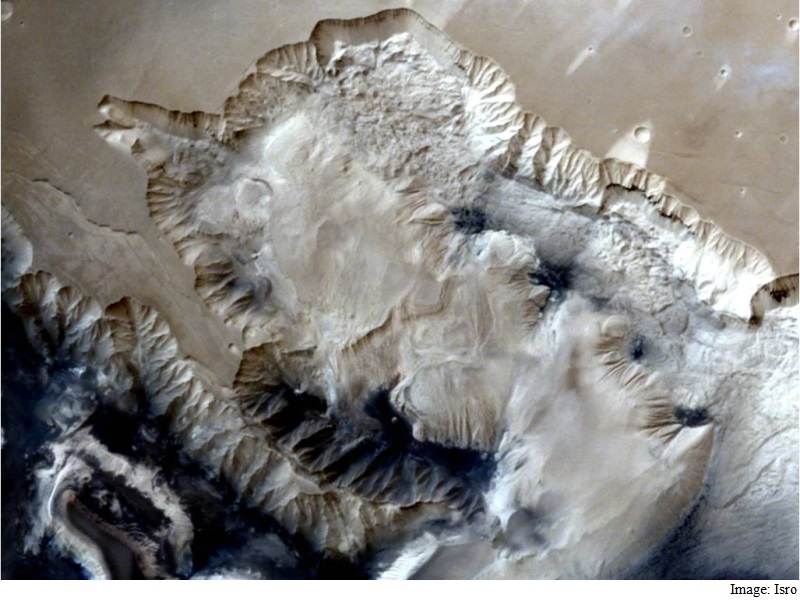- Home
- Science
- Science News
- Isro's Mangalyaan Sends Back Stunning 3D Images of Mars
Isro's Mangalyaan Sends Back Stunning 3D Images of Mars

The images taken by Mars Colour Camera (MCC) onboard Mangalyaan reflects the Ophir Chasma terrain, part of the Valles Marineris.
The word chasma has been designated by the International Astronomical Union to refer to an elongate, steep-sided depression.
The walls of the chasma contain many layers and the floors contain large deposits of layered materials.
This images were taken on July 19, 2015 at an altitude of 1, 857 km, the Indian Space Research Organisation said in a statement.
Five active spacecrafts are now orbiting the Red Planet, including Mangalyaan from India.
Nasa's Mars Atmosphere and Volatile Evolution (MAVEN) and India's Mars Orbiter Mission (Mangalyaan) joined the 2003 Mars Express from ESA (the European Space Agency) and two from Nasa - the 2001 Mars Odyssey and the 2006 Mars Reconnaissance Orbiter (MRO).
Nasa earlier this month said due to the high number of spacecraft orbiting Mars, it had no option but to beef up traffic monitoring, communication and manoeuvre planning to ensure that Mars orbiters do not collide with one another.
The newly-enhanced collision-avoidance system from the US space agency accurately warns if two orbiters approach each other too closely.
The new collision-avoidance process also tracks the approximate location of the Nasa's Mars Global Surveyor, a 1997 orbiter that is no longer working.
Get your daily dose of tech news, reviews, and insights, in under 80 characters on Gadgets 360 Turbo. Connect with fellow tech lovers on our Forum. Follow us on X, Facebook, WhatsApp, Threads and Google News for instant updates. Catch all the action on our YouTube channel.
Related Stories
- Samsung Galaxy Unpacked 2025
- ChatGPT
- Redmi Note 14 Pro+
- iPhone 16
- Apple Vision Pro
- Oneplus 12
- OnePlus Nord CE 3 Lite 5G
- iPhone 13
- Xiaomi 14 Pro
- Oppo Find N3
- Tecno Spark Go (2023)
- Realme V30
- Best Phones Under 25000
- Samsung Galaxy S24 Series
- Cryptocurrency
- iQoo 12
- Samsung Galaxy S24 Ultra
- Giottus
- Samsung Galaxy Z Flip 5
- Apple 'Scary Fast'
- Housefull 5
- GoPro Hero 12 Black Review
- Invincible Season 2
- JioGlass
- HD Ready TV
- Laptop Under 50000
- Smartwatch Under 10000
- Latest Mobile Phones
- Compare Phones
- Honor Win RT
- Honor Win
- Xiaomi 17 Ultra Leica Edition
- Xiaomi 17 Ultra
- Huawei Nova 15
- Huawei Nova 15 Pro
- Huawei Nova 15 Ultra
- OnePlus 15R
- Asus ProArt P16
- MacBook Pro 14-inch (M5, 2025)
- OPPO Pad Air 5
- Huawei MatePad 11.5 (2026)
- Xiaomi Watch 5
- Huawei Watch 10th Anniversary Edition
- Acerpure Nitro Z Series 100-inch QLED TV
- Samsung 43 Inch LED Ultra HD (4K) Smart TV (UA43UE81AFULXL)
- Asus ROG Ally
- Nintendo Switch Lite
- Haier 1.6 Ton 5 Star Inverter Split AC (HSU19G-MZAID5BN-INV)
- Haier 1.6 Ton 5 Star Inverter Split AC (HSU19G-MZAIM5BN-INV)

















